brakes AUDI A3 2012 Owner´s Manual
[x] Cancel search | Manufacturer: AUDI, Model Year: 2012, Model line: A3, Model: AUDI A3 2012Pages: 280, PDF Size: 70.11 MB
Page 208 of 280
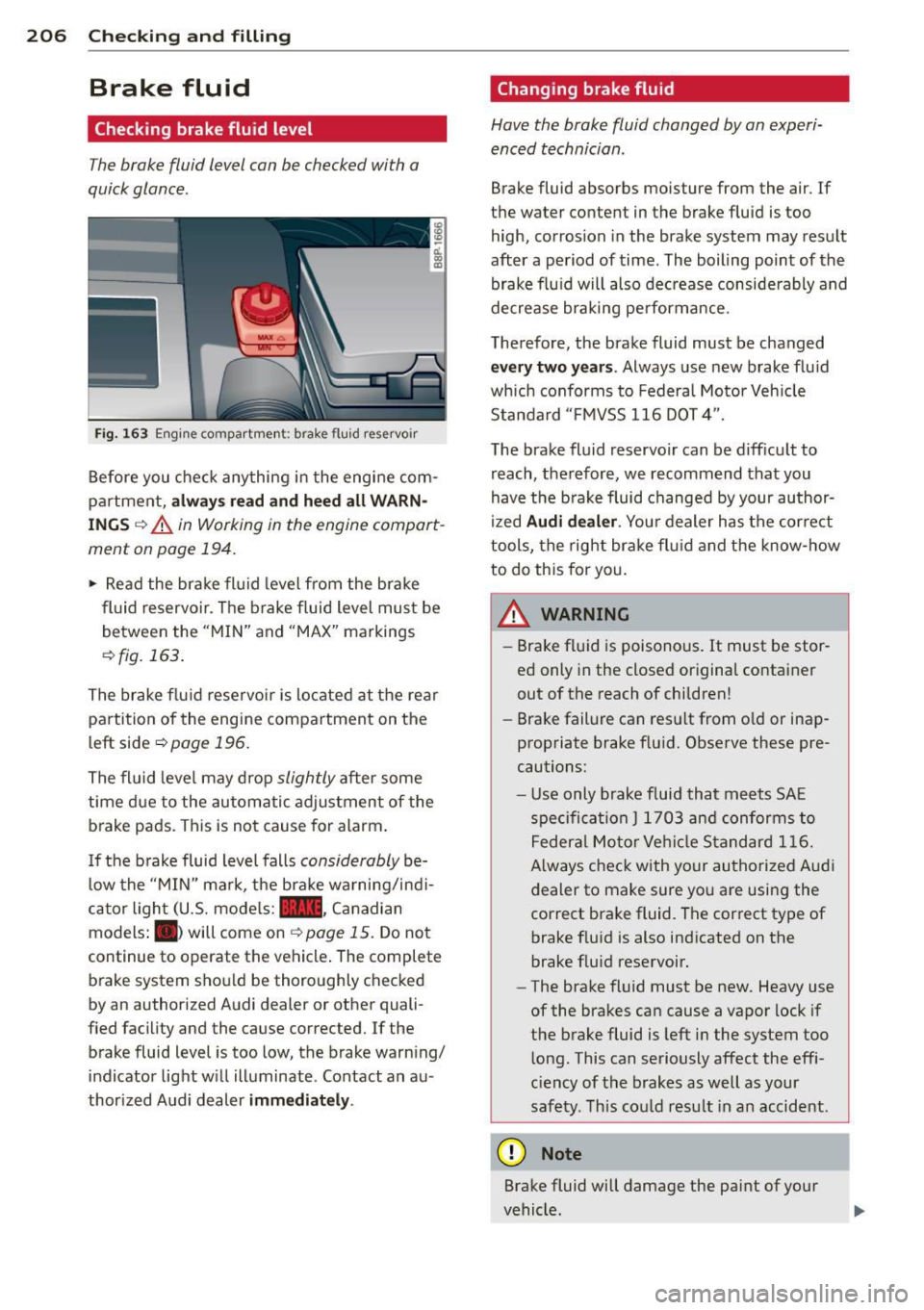
206 Checking and filling
Brake fluid
Checking brake fluid level
The brake fluid level can be checked with a
quick glance .
Fig. 163 Engine compartme nt: brake flu id reservo ir
Before you check anything i n the engine com
partment,
a lwa ys rea d and h eed a ll WA RN·
ING S c:> & in Working in the engine compart
ment on page
194.
~ Read the brake fluid level from the bra ke
fluid reservoir. The brake fluid Level must be
between the "MIN" and "MAX" markings
9fig. 163 .
The brake f lu id rese rvoir is located at the rear
partition of the engine compartment on the
L eft side
¢page 196.
The fluid level may drop slightly after some
time due to the automatic adjustment of the b rake pads . This is not cause for alarm .
I f the b rake fluid Level falls
considerably be
low the "MIN" mark, the brake wa rning/ind i
cator Light (U.S. models:
1111 , Canadian
models:
llllt will come on c:> page 15 . Do not
continue to operate the vehicle . The complete
brake system sho uld be thoroughly checked
by an authorized Audi dealer or other quali
fied facility and the cause corrected. If the
brake fluid level is too low, the brake warn ing/
indicator Light w ill illuminate . Contact an au
thor ized Audi dealer
imm ediatel y.
Changing brake fluid
Have the brake fluid changed by an experi
enced technician .
Brake fluid absorbs moisture from the air. If
the water content in the brake fluid is too high, corrosion in the brake system may result
after a period of time . The boiling point of the
brake flu id will also decrease conside rably and
decrease braking pe rformance.
Therefore, the brake fluid must be changed
eve ry two y ears. Always use new brake flu id
which conforms to Federal Motor Veh icle
Standard "F MVSS 116 DOT 4".
The brake fluid reservoir can be diff icult to
reach, therefore, we recommend that you
have the b rake fluid changed by your author
ized
Audi dealer . Your dealer has the correct
tools, the right brake fl uid and the know -how
to do this for you.
A WARNING
- Brake fluid is poisonous . It must be stor
ed only in the closed original container
out of the reach of children!
- Brake failure can resu lt from o ld or inap
propriate brake flu id. Observe these pre
cautions:
- Use only brake f luid that meets SA E
specifica tion
J 1 7 03 and conforms to
Federa l Moto r Ve hicl e Standard 1 16.
Always check with yo ur authorized Aud i
dealer to make sure yo u are using the
correct brake fluid. The correct type of brake f lu id is also ind icated on the
brake flu id reservoir.
- The brake fluid must be new. Heavy use
of the brakes can cause a vapor lock if
the brake fluid is left in the system too
l ong. This can seriously affect the effi
c iency of the brakes as well as your
safety. This cou ld resu lt in an accident.
(D Note
Brake fluid will damage the paint of your
vehicle .
Page 216 of 280

214 Tires and wheels
Maximum loaded vehicle weight
means the sum of:
(a) Curb weight
(b) Accessory weight
(c) Vehicle capacity weight, and
(d) Production options weight
Maximum (permissible) inflation pressure
means the maximum cold inflation pressu re
to which a tire may be inflated. Also called
"maximum inflation p ressure."
Normal occupant weight
means 150 lbs. (68 kilograms) times the
number of occupants seated in the vehicle up
to the total seating capacity of your vehicle.
Occupant distribution means distribution of occupants in a vehicle .
Outer diameter means the overa ll diameter of an inf lated new
tire.
Overall width
means the linear distance between the exteri
ors of the sidewalls of an inflated tire, includ
ing e levations due to labeling, decorations, or
protective bands or ribs.
Ply
means a layer of rubber-coated parallel cords.
Production options weight
means the comb ined weight of those installed
regular production options weighing over 5
lbs . (2 .3 kg) in excess of those standard items
which they replace, not previously considered
in curb weight or accessory weight, including
heavy duty brakes, r ide leve lers, roof rack,
heavy duty battery, and specia l trim .
Radial ply tire
means a pneumatic tir e in which the p ly cords
that extend to the beads are laid at substan
tially 90 degrees to the centerline of the
tread . Recommended inflation pressure
see
~
page 213, Cold tire inflation pressure.
Reinforced tire
means a t ire designed to operate at higher
loads and at higher inflation pressures than
the corresponding standard tire . Re inforced
t ir es my be identified as "XL", "xl", "EX TRA
LOAD", or "RF" on the sidewall.
Rim
means a metal support for a tire or a t ire and
tube assembly upon which the tire beads are seated.
Rim diameter
means nom inal d iameter of the bead seat. If
you change your wheel s ize, you w ill have to
purchase new tires to match the new r im di
ameter .
Rim size designation
means rim diameter and width.
Rim width
means nominal distance between rim flanges .
Sidewall
means that portion of a tire between the
t read and bead.
Speed rating (letter code)
means the speed at which a tire is designed to
be driven for extended periods of time. The
ratings range from 93 mph (150 km/h) to
186 mph (298 km/h)
~ page 224 . You may
not find this information on all tires because
it is not requ ired by law.
The speed rating letter code, where applica
ble, is molded on the tire sidewall and indi
cates the max imum pe rmissibl e road speeds
~ A in Winter tires on page 228.
Tire pressure monitoring system*
means a system that detects when one or
more of a veh icle's tires are underinflated and
illuminates a low tire pressure warning tell
tale.
Page 220 of 280
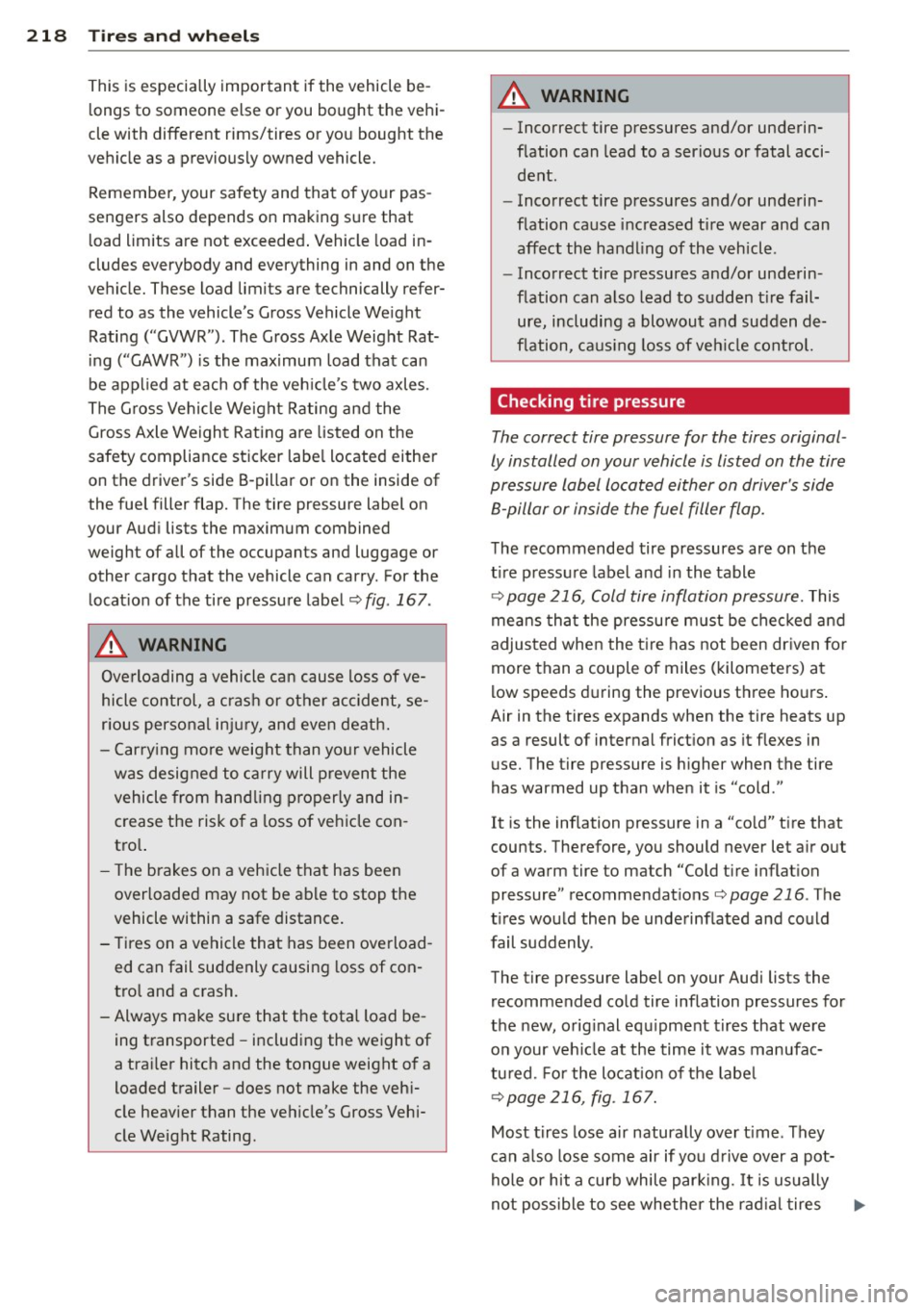
218 Tires and wheels
This is especia lly important if the vehicle be
longs to someone else or you bought the vehi
cle with different rims/tires or you bought the
vehicle as a previously owned vehicle.
Remember, your safety and that of your pas
sengers also depends on making sure that
load limits are not exceeded. Vehicle load in
cludes everybody and everything in and on the
vehicle. These load limits are technically refer
red to as the vehicle's Gross Vehicle Weight
Rating (' 'GVWR"). The Gross Axle Weight Rat
ing ("GAWR") is the maximum load that can
be applied at each of the vehicle's two axles.
The Gross Vehicle Weight Rating and the
Gross Axle Weight Rating are listed on the
safety compliance sticker label located either
on the driver's side B-pillar or on the inside of
the fuel filler flap. The tire pressure label on
your Audi lists the maximum combined
weight of all of the occupants and luggage or
other cargo that the vehicle can carry. For the
location of the tire pressure label
o fig. 167.
_& WARNING
Overloading a vehicle can cause loss of ve
hicle control, a crash or other accident, se
rious personal injury, and even death.
- Carrying more weight than your vehicle
was designed to carry will prevent the
vehicle from handling properly and in
crease the risk of a loss of vehicle con
trol.
- The brakes on a vehicle that has been
overloaded may not be able to stop the
vehicle within a safe distance.
- Tires on a vehicle that has been overload
ed can fail suddenly causing loss of con
trol and a crash.
- Always make sure that the total load be
ing transported -including the weight of
a trailer hitch and the tongue weight of a
loaded trailer -does not make the vehi
cle heavier than the vehicle's Gross Vehi
cle Weight Rating.
A WARNING
- Incorrect tire pressures and/or underin
flation can lead to a serious or fatal acci
dent.
- Incorrect tire pressures and/or underin
flation cause increased tire wear and can affect the handling of the vehicle.
- Incorrect tire pressures and/or underin
flation can also lead to sudden tire fail
ure, including a blowout and sudden de
flation, causing loss of vehicle control.
Checking tire pressure
The correct tire pressure for the tires original
ly installed on your vehicle is listed on the tire
pressure label located either on driver's side 8-pillar or inside the fuel filler flap.
The recommended tire pressures are on the
tire pressure label and in the table
o page 216, Cold tire inflation pressure. This
means that the pressure must be checked and
adjusted when the tire has not been driven for
more than a couple of miles (kilometers) at
low speeds during the previous three hours.
Air in the tires expands when the tire heats up
as a result of internal friction as it flexes in
use. The tire pressure is highe r when the tire
has warmed up than when it is "cold ."
It is the inflation pressure in a "cold" tire that
counts. Therefore, you should never let air out
of a warm tire to match "Cold tire inflation
pressure" recommendations
o page 216. The
tires would then be underinflated and could
fail suddenly.
The tire pressure label on your Audi lists the
recommended cold tire inflation pressures for
the new, original equipment tires that were
on your vehicle at the time it was manufac
tured. For the location of the label
opage 216, fig. 167.
Most tires lose air naturally over time . They
can also lose some air if you drive over a pot
hole or hit a curb while parking. It is usually
not possible to see whether the radial tires ..,.
Page 223 of 280
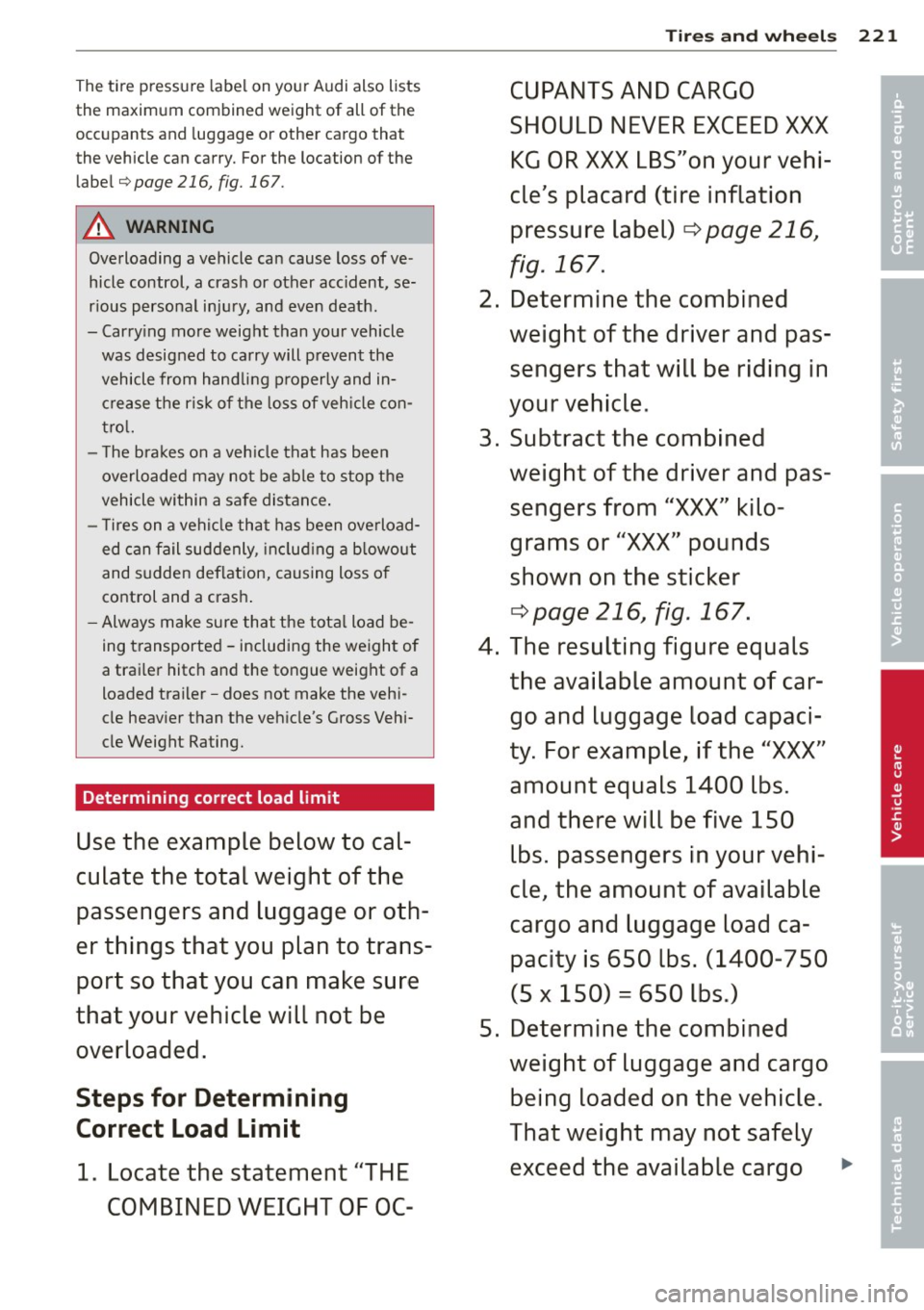
The tire pressure label on your Audi also lists
the maximum combined weight of all of the
occupants and luggage or other cargo that
the vehicle can carry. For the location of the
label
c:::>page 216, fig. 167.
A WARNING
Overloading a vehicle can cause loss of ve
hicle control, a crash or other accident, se
rious personal injury, and even death.
- Carrying more weight than your vehicle was designed to carry will prevent the
vehicle from handling properly and increase the risk of the loss of vehicle con
trol.
- The brakes on a vehicle that has been
overloaded may not be able to stop the
vehicle within a safe distance.
- Tires on a vehicle that has been overload
ed can fail suddenly, including a blowout
and sudden deflation, causing loss of
control and a crash.
- Always make sure that the total load be
ing transported -including the weight of
a trailer hitch and the tongue weight of a
loaded trailer -does not make the vehi
cle heavier than the vehicle's Gross Vehi
cle Weight Rating.
Determining correct load limit
Use the example below to cal
culate the total weight of the
passengers and luggage or oth
er things that you plan to trans
port so that you can make sure
that your vehicle will not be
overloaded.
Steps for Determining
Correct Load Limit
1. Locate the statement "THE
COMBINED WEIGHT OF QC-
Tires and wheels 221
CUPANTS AND CARGO
SHOULD NEVER EXCEED XXX
KG OR XXX LBS"on your vehi
cle's placard (tire inflation
pressure label)
¢ page 216,
fig. 167.
2. Determine the combined
weight of the driver and pas
sengers that will be riding in
your vehicle.
3. Subtract the combined
weight of the driver and pas
sengers from
"XXX" kilo
grams or
"XXX" pounds
shown on the sticker
¢ page 216, fig. 167.
4. The resulting figure equals
the available amount of car
go and luggage load capaci
ty. For example, if the
"XXX"
amount equals 1400 lbs.
and there will be five 150
lbs. passengers in your vehi
cle, the amount of available
cargo and luggage load ca
pacity is 650 lbs. (1400-7 50
(5
X 150) = 650 lbs.)
5. Determine the combined
weight of luggage and cargo
being loaded on the vehicle.
That weight may not safely
exceed the available cargo
•
•
Page 228 of 280

226 Tires and wheels
and drive with extra care. Refit the nor
mal road wheel as soon as safely possi
ble.
- Never drive faster than the maximum
speed for which the tires on your vehicle
are rated because tires that are driven
faster than their rated speed can fail
suddenly.
- Overloading tires cause heat build-up,
sudden tire failure, including a blowout
and sudden deflation and loss of control.
- Temperature grades apply to tires that are properly inflated and not over or un
derinflated .
- For technical reasons it is not always
possible to use wheels from other vehi
cles -in some cases not even wheels
from the same vehicle model.
- If you install wheel trim discs on the ve
hicle wheels , make sure that the air flow
to the brakes is not blocked. Reduced air
flow to the brakes can them to overheat,
increasing stopping distances and caus
ing
a collision.
- Run flat tires may only be used on vehi cles that were equipped with them at the
factory. The vehicle must have a chassis designed for run flat tires and a factory
installed tire pressure monitoring sys
tem* that indicates a loss of tire pres
sure . Incorrect use of run flat tires can
lead to vehicle damage or accidents .
Check with an authorized Audi dealer or
tire specialist to see if your vehicle can be
equipped with run flat tires . If run flat
tires are used, they must be installed on
all four wheels. Mixing tire types is not
permitted .
(D Note
-For technical reasons, it is not generally
possible to use the wheel rims from oth
er vehicles. This can hold true for wheels
of the same vehicle type.
- If the spare ti re is different from the
tires that you have mounted on your ve
hicle (for example winter tires or wide
profile tires), then use the spare tire for a short period of time only and
drive with
extra care. Replace the flat tire with the
tire matching the others on your vehicle
as soon as possible.
- If you put different wheels and tires on
your vehicle (e .g. winter wheels and
tires), you must be certain that the
wheels and tires are compatible with the
tire pressure monitoring system* . Other
wise the system will register a malfunc
tion and a fault message will be dis
played. For more information, contact
your authorized Audi dealer.
- Never drive without the valve stem cap .
The valves could get damaged .
@ For the sake of the environment
Dispose of old tires in accordance with the
local requirements.
Uniform tire quality grading
- Tread wear
- Traction AA A B C
- Temperature ABC
Quality grades can be found where applicable
on the tire side wall between tread shoulder
and maximum section width
¢ page 223,
fig. 171 .
For example: Tread wear 200, Traction AA,
Temperature A.
All passenger car tires must conform to Feder
al Safety Requirements in addition to these
grades .
Tread wear
The tread wear grade is a comparative rating
based on the wear rate of the tire when tested
under controlled conditions on a specified
government test course.
For example, a tire graded 150 would wear
one and one half (11/2) times as well on the
government course as a tire graded 100.
The relative performance of tires depends
upon the actual conditions of their use, how-
ever, and may depart significantly from the
ll-
Page 246 of 280
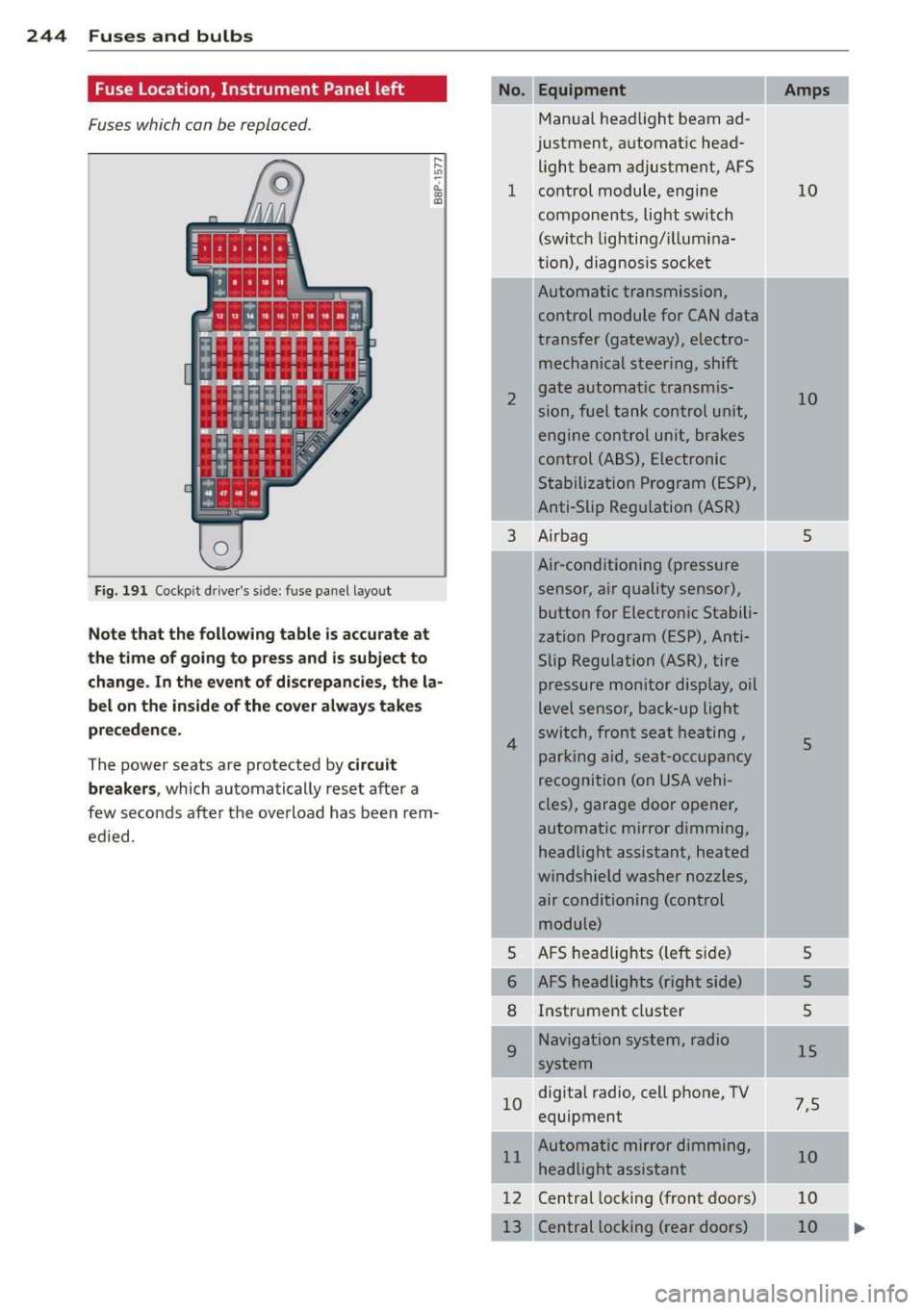
244 Fuses and bulbs
Fuse Location, Instrument Panel left
Fuses which can be replaced.
Fig. 191 Cockp it driver 's s ide: fuse pane l layout
Note that the following table is accurate at
the time of going to pr ess and i s subject to
change . In the event of d iscrepancies, the la
bel on the in side of the cover always take s
pr eceden ce .
The power seats are protected by circuit
break ers,
which automatically reset after a
few seconds after the ove rload has been rem
ed ied .
Equipment
Manua l head light beam ad
justment, a utomat ic head
light beam adjustment, AFS
1 co ntrol m odule, engine
components, light switch
(switch lighting/illumina
ti on), diagnosis socke t
2
3
4
5
6
8
9
Automatic transmission,
control module for CAN data
transfer (gateway), electro
mechanical steering, shift
gate automatic transmis
sion, fuel tank control unit,
engine control unit, brakes
control (A BS), Electronic
Stabili zation Program (ESP) ,
Anti-Slip Regulation (ASR)
Air bag
Air-conditioning (pressure
sensor, air quality sensor), button for Electronic Stabili
zation Program (ESP), Anti
Slip Regulat ion
(ASR), tire
pressure monitor display, oil
level senso r, back-up ligh t
s w itch, front se at he ati ng ,
p ark ing aid, sea t-occupancy
recognition (on USA vehi
cles), garage door opener,
automa tic mirror dimming,
headlight assistant, heated
windshield washer nozzles, air conditioning (control
module)
AFS headlights ( left si de)
AFS headlights (right side) Instr ument cluster
Navigation system, radio
system
1 0 digital
radio, cell phone, TV
equipment
11 Automatic mirror dimming,
headlight assistant
12 Central lock ing (front doors)
Central locking ( rear doors)
Amps
10
10
5
5
5
5
5
15
7 ,5
10
10
10
Page 267 of 280
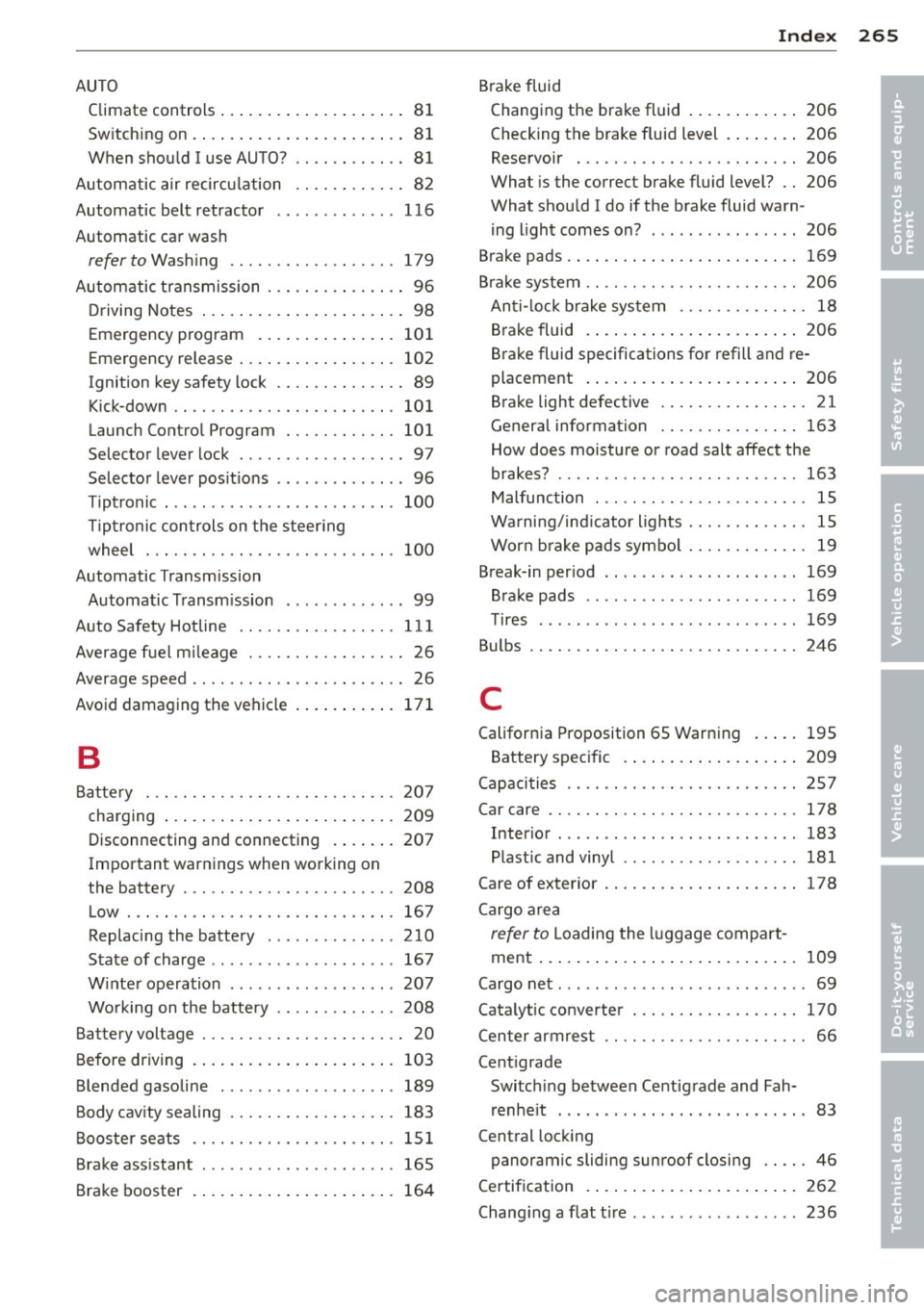
Index 265 ____________________________ ...:.:..:.=.:::.::.:
AUTO
Climate controls .. ..... ... .. .. .. .... 81
Sw itching on .... ........ ... .. .. .. .. 81
When should I use AUTO? ............ 81
Automatic air recircu lation ............ 82
Automatic belt retractor . . . . . . . . . . . . . 116
Automatic car wash
refer to Washing .................. 179
Automatic t ransmission . . . . . . . . . . . . . . . 96
D riving Notes . . . . . . . . . . . . . . . . . . . . . . 98
Emergency program ... ... .. .. .. .. . 10 1
Emergency release . . . . . . . . . . . . . . . . . 102
Ignition key safety lock . . . . . . . . . . . . . . 89
Kick-down .. ... .......... .. .. .. ... 101
Launch Contro l Program ..... .. .. .. . 101
Selector lever lock .................. 97
Selector lever pos it ions . . . . . . . . . . . . . . 96
Tiptronic . . . . . . . . . . . . . . . . . . . . . . . . . 100
Tiptroni c con trols on the steering
wheel . .. .. .... ............. .. .. . 100
Automatic Transmission
Automatic T ransm ission ....... .. .. .. 99
Auto Safety Hotline . . . . . . . . . . . . . . . . . 111
Average fue l m ileage ................. 26
Average speed . . . . . . . . . . . . . . . . . . . . . . . 26
Avoid damaging the vehicle . ... .. .. .. . 17 1
B
Battery . .. .. ................. .. .. . 20 7
charging ... .. .... .... ... .. .. .. ... 209
Disconnecting and connecting . ... .. . 207
Important warn ings when working on
the battery . ............. .... .. ... 208
Low . .... .. .. .. ........... ....... 167
Replacing the batte ry ...... ... .. .. . 210
State of charge .................... 167
W inte r operation .......... ...... .. 207
Wo rking on t he battery ............. 208
Battery voltage . . . . . . . . . . . . . . . . . . . . . . 20
B efore driving . .. .. ..... ... .. .. .. ... 103
B lended gasoline . .......... ...... .. 189
Body cavity sealing .................. 183
B ooste r seats .. ........... .. .. .. ... 1 51
Brake assistant ............. ...... .. 165
Brake booster .... .. .... ... .. .. .. ... 164 Brake fluid
Changing the bra ke fluid ..... ... .. .. 206
Check ing the brake fluid level . ... .. .. 206
Reservoir . .. .. .. ................. 206
What is the correct brake fluid level? .. 206
What should I do if the brake fluid warn-
ing light comes on? .. .. .. ..... ... .. 206
Brake pads . ... .. .. .. .. .. ...... ... .. 169
B rake system ....................... 206
An ti-l ock b rake syste m . . . . . . . . . . . . . . 18
B rake fluid .. .... .. . .. .. ..... ... .. 206
Brake fluid specifications for refill and re-
placement .. .... ... .. .. ..... ... .. 206
Brake light defective ................ 21
General information ............... 163
How does moistu re or road salt affect the
brakes? .......... ................ 163
Malfunction ..... .. ................ 15
Wa rning/ind icator lights ........ .. .. . 15
Wor n bra ke pads s ymbol ............ . 19
Break-in per iod .. .. .... ....... ...... 169
B rake pads ....................... 169
T ires 169
Bul bs ............................. 246
C
California Proposition 65 Warning ... .. 195
Battery specific . ... .. ...... ... .. .. 209
Capaci ties ......................... 257
Car care . . . . . . . . . . . . . . . . . . . . . . . . . . . 178
Interior . . . . . . . . . . . . . . . . . . . . . . . . . . 183
Plastic and vinyl .. .. . .. .. ..... ... .. 181
Care of exterior .. ...... ............. 178
Cargo a rea
refer to L oading the l uggage compa rt-
ment ... .. .. .. .... . ... ...... ... .. 109
Cargo net . . . . . . . . . . . . . . . . . . . . . . . . . . . 69
Cata lytic converter .............. .... 170
Center armres t . . . . . . . . . . . . . . . . . . . . . . 66
Cent igrade
Switching between Centig rade and Fah-
renhe it . ..... ...... ....... ........ 83
Central locking
panoramic sliding sunroof closing .. .. . 46
Certif ication .. .... ... .. .. ..... ... .. 262
Chang ing a flat t ire ... . .. .. ..... ... .. 236
•
•